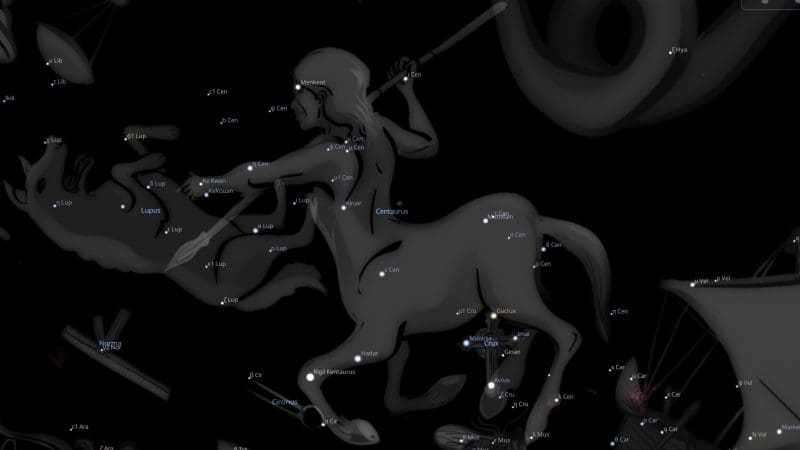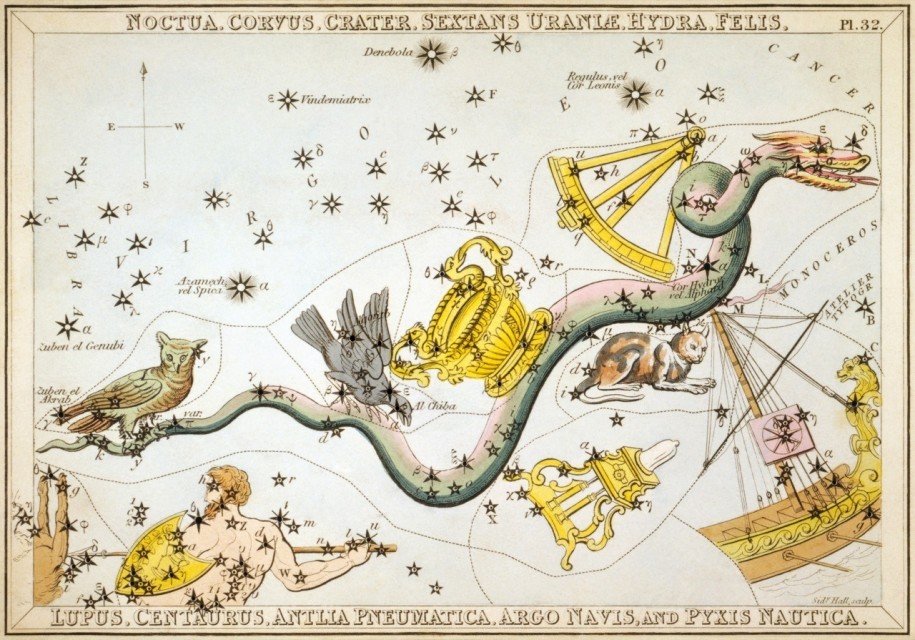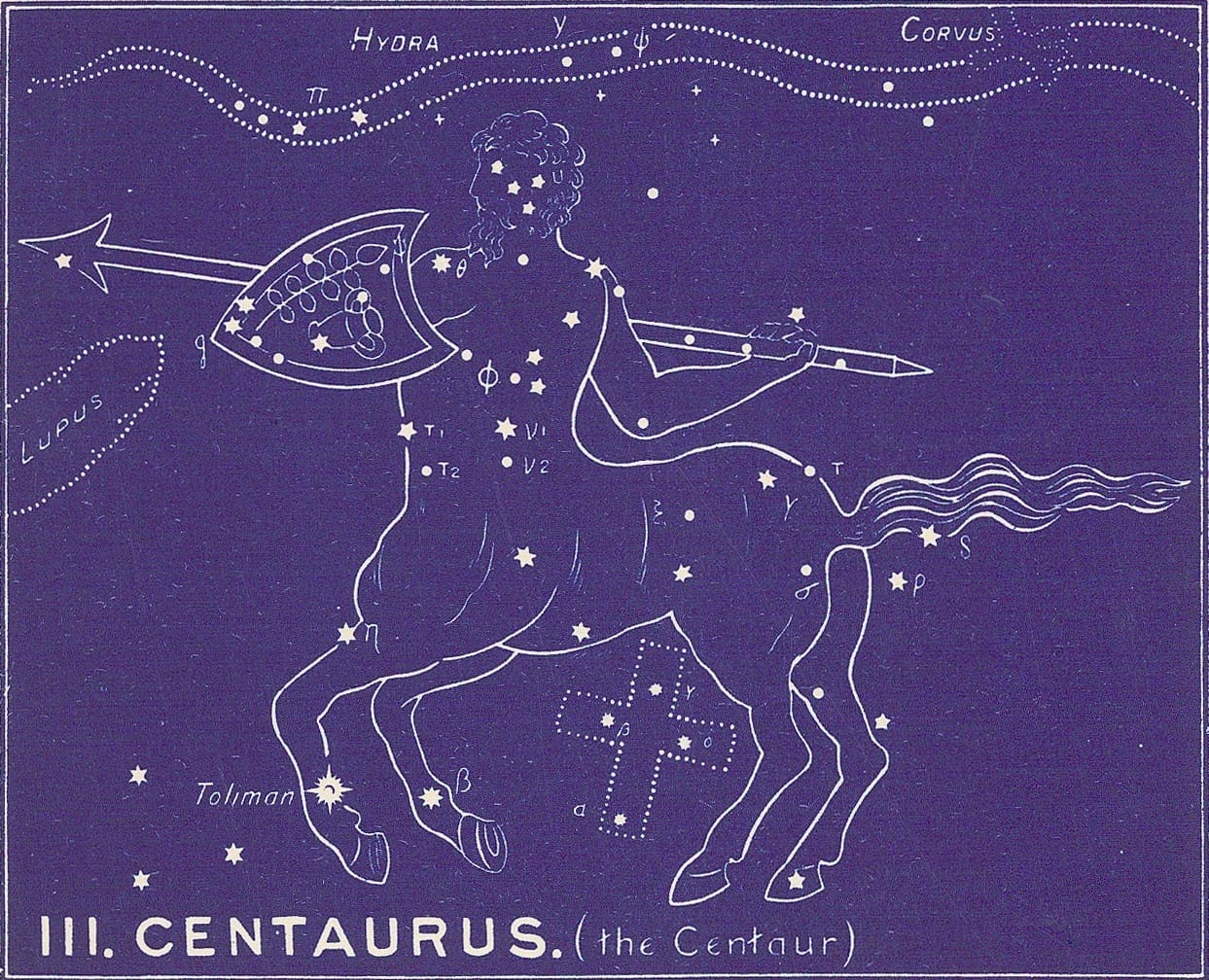FIXED STARS: Major Stars | 1000+ Stars | Constellations | About
Constellation Centaurus The Centaur is a southern constellation bordering Hydra, Antlia, Vela, Carina, Musca, Crux, Circinus, Lupus and the obsolete constellations Argo Navis, Robur Carolinum and Noctua.Centaurus is one of the 48 constellations listed by Ptolemy in the 2nd century and remains one of the 88 modern constellations. It spans 40 degrees of the zodiac in the Signs of Libra and Scorpio.
Abbreviation: Cen
Genitive: Centauri
Centaurus Constellation Stars
| 2000 | 2050 | Star | Name | Sp. Class | Mag. | Orb |
|---|---|---|---|---|---|---|
| 22♎12 | 22♎53 | π Cen | B5 | 3.90 | 1°30′ | |
| 27♎29 | 28♎11 | δ Cen | Ma Wei | B2 | 2.58 | 2°00′ |
| 29♎23 | 00♏05 | ρ Cen | B3 | 3.97 | 1°30′ | |
| 00♏43 | 01♏25 | σ Cen | B3 | 3.91 | 1°30′ | |
| 01♏19 | 02♏01 | τ Cen | A2 | 3.85 | 1°30′ | |
| 02♏19 | 03♏01 | γ Cen | Muhilfain | A1 | 2.20 | 2°10′ |
| 03♏07 | 03♏49 | ι Cen | Alhakin | A2 | 2.75 | 2°00′ |
| 04♏32 | 05♏14 | λ Cen | Mati | B9 | 3.11 | 1°40′ |
| 06♏28 | 07♏10 | d Cen | G8 | 3.90 | 1°30′ | |
| 11♏09 | 11♏51 | ν Cen | Kabkent Secunda | B2 | 3.41 | 1°40′ |
| 11♏32 | 12♏14 | μ Cen | Kabkent Prima | B2 | 3.47 | 1°40′ |
| 12♏18 | 13♏00 | θ Cen | Menkent | K0 | 2.06 | 2°10′ |
| 13♏02 | 13♏44 | φ Cen | Kabkent Tertia | B2 | 3.83 | 1°30′ |
| 14♏20 | 15♏02 | υ1 Cen | B2 | 3.87 | 1°30′ | |
| 14♏57 | 15♏39 | ζ Cen | Alnair | B2 | 2.55 | 2°00′ |
| 15♏33 | 16♏15 | ε Cen | Al Birdhaun | B1 | 2.29 | 2°10′ |
| 20♏14 | 20♏57 | η Cen | Marfikent | B1 | 2.33 | 2°10′ |
| 23♏47 | 24♏29 | β Cen | Agena | B1 | 0.61 | 2°40′ |
| 24♏47 | 25♏29 | κ Cen | Ke Kwan | B2 | 3.13 | 1°40′ |
| 29♏24 | 00♐06 | α Cen | Toliman | G2 | 0.01 | 2°40′ |
α Cen is named Rigil Kentaurus, but astrologers call it Toliman.
β Cen is named Bungula, but astrologers call it Agena.
γ Cen is named Muhlifain, from the Arabic محلفين muħlifayn, meaning :two [things] causing dispute and the swearing of an oath. [1]
δ Cen has the Chinese name Ma Wei, from 馬尾 (Mǎ Wěi), meaning “Horse’s Tail.” [2]
ε Cen has the Arabic name Birdun or Al Birdhaun (البرﺬﻮﻦ), meaning “the packhorse.” [3] It also has the Chinese name Nan Men, from 南門 (Nán Mén), meaning “Southern Gate.” [2]
ζ Cen is named Alnair, an abbreviation of the Arabic نير بطن قنطورس, nayyir baṭan qanṭūris, “the Bright One in the Body of the Centaur.” Alnair was taken from a wrong translation of (Al Nair) of the Arabic word nayyir (“Bright”). [1]
η Cen has the Arabic name Marfikent, meaning “elbow of the centaur.” [4] It also has the Chinese name Koo Low from 庫樓 (Kù Lóu), meaning “Arsenal.” [2]
θ Cen is named Menkent, applied in recent times and possibly coined from the Arabic word mankib, “shoulder” (is some recent transliterations: menkib; Ptolemy described this star on the right “shoulder” of the Centaur). [1]
ι Cen has the Arabic name Alhakim, derived from the Arabic title Kentaurus al-Hakeem (قنطورس الحكيم), meaning “wise centaur”. [5]
κ Cen has the Chinese name Ke Kwan, meaning “Cavalry Officer.” [6] It belongs to the asterism 騎官 (Qí Guān), meaning “Imperial Guards.” [2]
λ Cen has the Chinese name Ma Ti, meaning “horse’s hoof .” As the fifth star in the asterism of the Sea and Mountain, it also has the name 海山五 (Hǎishānwu), “The Greatest of the Greatest.” [7]
μ Cen has the traditional name Kabkent Prima, derived from a mixture of Arabic and Latin, meaning “the first heart of the centaur.” [8]
ν Cen is Kabkent Secunda, “second heart of the centaur.”
φ Cen is Kabkent Tertia, “third heart of the centaur.”
Centaurus Astrology
Manilius
The Centaur, from his own nature assigns qualities to his progeny. Such a one will either urge on asses with the goad and yoke together quadrupeds of mixed stock or will ride aloft in a chariot; else he will saddle horses with a fighter or drive them into the fight…Another knows how to apply the arts of healing to the limbs of animals and to relieve the dumb creatures of the disorders they cannot describe for his hearing…His is indeed a calling of skill, not to wait for the cries of pain, but recognize betimes a sick body not yet conscious of its sickness. [9]
Robson
Legend. This constellation probably represents Pholos, son of Silenus and Meila, who was accidentally wounded in the foot by one of Hercules’ poisoned arrows. According to some accounts it is Chiron, but he is more correctly associated with Sagittarius.
Influence. According to Ptolemy the stars in the human part of the figure are of the nature of Venus and Mercury, and the bright stars in the horse’s part of Venus and Jupiter. It is said to give hard-heartedness, inclination to vengeance, love of arms, strong passion, and an energetic nature. It may be connected with poisons.
Magical. Gives health and long life. [10]
Noonan
Astrologically the constellation gives wisdom and proficiency in botany, music, astronomy, divination and medicine. [11]
Allen
The Greeks called constellation Centaurus the Centaur, or the “Horseman Beast. This, too, was the special designation of the classical Pholus…the hospitable one of the family…this centaur’s transformation to the sky as our constellation, with the fitting designation ‘Well Disposed’…In its transcribed forms Chiron and Chyron…This has appropriately the handy One, a rendering that well agrees with this Centaur’s reputation.
He was imagined as a mild and noble look, very different from the threatening aspect of the centaur Sagittarius; and Saint Celement of Alexandria wrote of him that he first led mortals to righteousness. His story has been thought in some degree historic, even by Sir Isaac Newton. As the wisest and most just of his generally lawless race he was beloved by Apollo and Diana, and from their teaching became proficient in botany and music, astronomy, divination and medicine, and instructor of the most noted heroes.
Indeed he was the legendary inventor of the constellations…and the father of Hippo, mentioned by Euripedes as foretelling events from the stars… Hyde is our authority for another title (from Albumasar), Birdun, the Pack-horse… Sagittarius undoubtedly was the original Centaur and from the Euphrates, the Centaur of the South probably being of Greek conception… This is one of the largest constellations, more than 60° in length, its p152 centre about 50° south of the star Spica below Hydra’s tail. [6]
Bullinger
“It is the figure of a being with two natures. Jamieson, in his Celestial Atlas, 1822, says, “On the authority of the most accomplished Orientalist of our own times, the Arabic and Chaldaic name of this constellation is Bezeh.” Now this Hebrew word Bezeh (and the Arabic Al Beze) means the despised. It is the very word used of this Divine sufferer in Isaiah 53:3, “He is DESPISED and rejected of men.”
The constellation contains thirty-five stars. Two of the 1st magnitude, one of the 2nd, six of the 3rd, nine of the 4th, etc., which, together with the four bright stars in the CROSS make a brilliant show in southern latitudes. Another name for the constellation was in Hebrew, Asmeath, which means a sin-offering (as in Isaiah 53:10).
The Greek name was Cheiron, which means the pierced, or who pierces. In the Greek fables Cheiron was renowned for his skill in hunting, medicine, music, athletics, and prophecy. All the most distinguished heroes of Greece are described as his pupils. He was supposed to be immortal, but he voluntarily agreed to die; and, wounded by a poisoned arrow (not intended for him) while in conflict with a wild boar, he transferred his immortality to Prometheus; whereupon he was placed amongst the stars.
We can easily see how this fable is the ignorant perversion of the primitive Revelation. The true tradition can be seen dimly through it, and we can discern Him of whom it spoke,–the all-wise, all-powerful Teacher and Prophet, who “went about doing good,” yet “despised and rejected of men,” laying down His life that others might live.
It is one of the lowest of the constellations, i.e. the farthest south from the northern center. It is situated immediately over the CROSS, which bespeaks His own death; He is seen in the act of destroying the enemy. Thus these star-pictures tell us that it would be as a child that the Promised Seed should come forth and grow and wax strong in spirit and be filled with wisdom (Luke 2:40); and that as a man having two natures He should suffer and die. Then the third and last section in this first chapter of this First Book goes on to tell of His second coming in glory.” [12]
References
- A Dictionary of Modern Star Names, Kunitzch, Smart, 2006, p.22, 28.
- List of Chinese Star Names – Wikipedia
- Epsilon Centaurus – Wikipedia.
- Eta Centauri – Wikipedia
- Iota Centauri – Wikipedia
- Star Names: Their Lore and Meaning, Richard Hinckley Allen, 1889, p.148-151.
- Lambda Centauri – Wikipedia
- Mu Centauri – Wikipedia
- Astronomica, Manilius, 1st century A.D, book 5, p.329.
- Fixed Stars and Constellations in Astrology, Vivian E. Robson, 1923, p.36-37, 231.
- Fixed Stars and Judicial Astrology, George Noonan, 1990, p.72
- The Witness of the Stars, E. W. Bullinger, 1893, Centaurus (the Centaur).
[wp_ad_camp_3]


